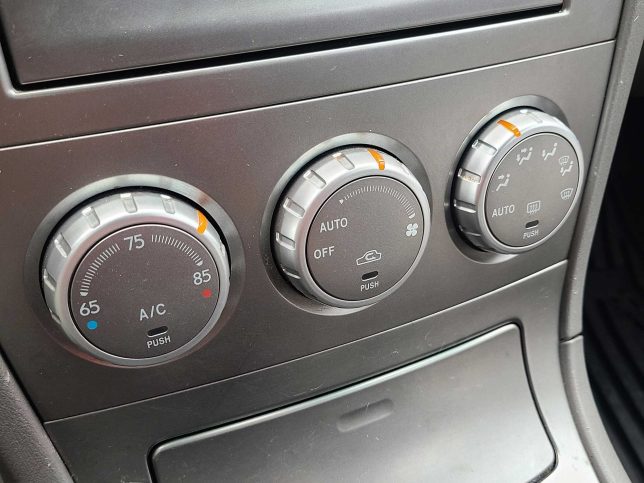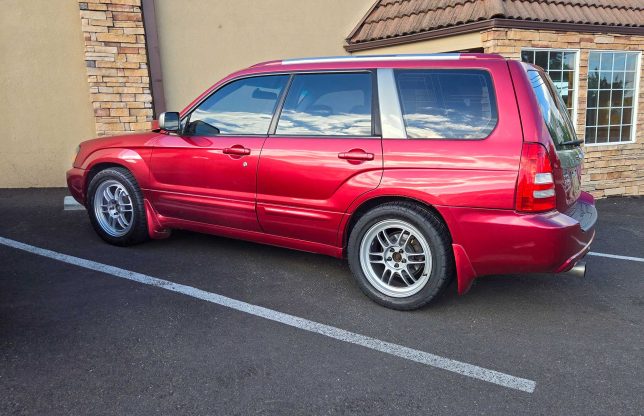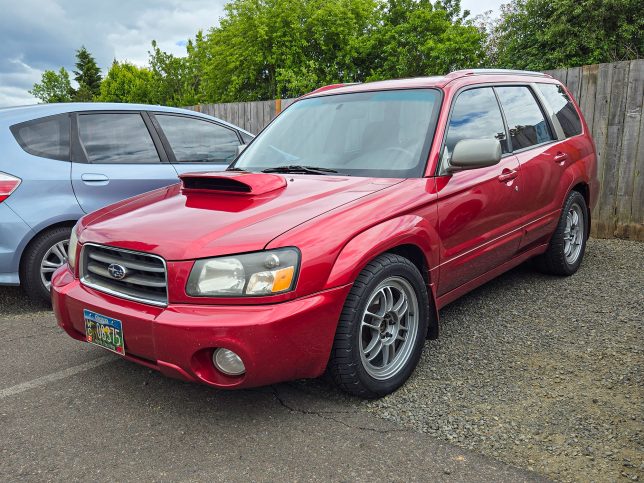Back in January 2024, we bought a 2005 Subaru Forest XT. It had 190,000 miles, a bunch of go-fast mods, and was ready to inject some speed into our fleet. So what have we been up to with it since? Quite a bit, actually.
Why We Bought a Subaru Forester XT
It’d been a while since we had a fast car; arguably since our 2013 Subaru Impreza WRX which we sold in 2017. We’ve had plenty of pokey modes of transport since, so it was time for some rapid transit. The SG generation Forester XT is such a neat blend of utility and performance. It has the shape of a wagon, the heart of a WRX, and the soul of a rally car.
This was also our first “bought, not built” car. It already has a bunch of respectable modifications including a larger Grimspeed intercooler, Cobb intake and stage 2 tune, up and down pipes, Strömung exhaust, K-Sport coilovers, braided brake lines, Whiteline sway bar, and some sort of shift kit. Plus, the previous owner did a good job maintaining it. Yes, it has a lot of miles, but it feels solid and well-sorted. It’s a blast to drive, sounds amazing, and looks like a ruby-red rally car with the aerodynamics of a shipping container. It’s perfect for our fleet.
New BFGoodrich g-Force Comp-2 Plus A/S Tires, Updated Enkei RPF1 Wheels

Immediately after buying this Forester, we knew the factory 215/65R15-sized rubber would need to be replaced. While there was plenty of tread left, the tires were hard touring-style all-season tires. With the amount of power the car makes, traction was an issue, especially in wet conditions.
Since we’ll be driving this car year-round, a dedicated summer tire wouldn’t fit the bill. But, an ultra high-performance all-season tire was what we were after. We turned to BFGoodrich and opted for their g-Force Comp-2 A/S Plus tire in 235/50R17. This tire would be wider with a smaller sidewall, and a softer compound than the rock-hard rubber we had on it before. Plus, the BFGs have a 45,000-mile treadwear warranty.
I mounted the BFGs on a set of wheels I’d always admired, the iconic Enkei RPF1. A friend of mine had these available, and they were the just right size—17×7.5, 5×100, and a +48 offset. Plus, they weigh just 15.25 lbs. They’re in good shape, too. This was a definite score.
We got a chance to put the new rolling stock to the test on a Saturday rally at a Cascade Sports Car Club Gear Grinders TSD rally. It was immediately apparent that these tires were great. The car went from a drift missle on the stock-sized tires to a grip monster. No matter how hard I threw our Wine Wagon into the corners, the BFG tires never broke traction. We’ll have a full review of them coming up.
Regular Maintenance
First things first, I always change out a new-to-me vehicle’s fluids. In went some new gearbox oil (it’s a five-speed), the diffs got fresh lube, and I did an oil change. The previous owner included a replacement A/C belt and pulley, too, as the bearing on the pulley was starting to whine like a supercharger, so the belt and pulley went on and that was fixed. New wipers were also installed. It’s the little things, you know?
Finicky HVAC Panel

Oddly, the Forester’s climate control panel kept randomly cutting in and out. This meant no heat or defrost in the winter months or A/C or fan in the summer. I pulled the panel, jiggled wires, and couldn’t replicate it. I went as far as to pull everything apart to check for bad solder joints or other electrical issues, but no dice.
I figured the panel must simply be shot. So, I hopped on eBay and ordered a used panel from LKQ (it had a 90-day warranty). It took about 10 minutes to replace and it immediately worked. However, that fix didn’t last more than two weeks, and the panel started doing the same thing. I figured it must be a wiring issue.
Again, I jiggled wires. I wobbled fuses. But no matter what I did, I couldn’t replicate the issue. Reluctantly, I brought the car into a local mechanic who eventually told me he thought the panel was bad. I mean, what were the chances of that? Thankfully, LKQ refunded my money, and I bought yet another HVAC panel from LKQ. Since installing it, I’ve had no issues. I’ll officially call that fixed.
Cam Position Sensor and Tumble Generator Sensor
One day I randomly got a check engine light, that dreaded glowing amber beacon of disappointment. I went to start the car, and it stumbled badly, kept cranking, and on came the CEL. A quick read with an OBDII scanner showed it was the bank 1 cam position sensor. It was a $50 fix and an hour’s worth of time.
Not long after that, I got yet another check engine light. This time, the OBDII scanner told me it was the tumble generator valve sensor. You know the … uh … wait, what’s a tumble generator?

Apparently, tumble generators are block-off plates placed upstream of the fuel injectors on some Subaru engines. These motor-actuated butterflies create a vortex in intake air for a cleaner burn and leaner air-fuel mixture during cold-start and low-speed operation, as was explained on a forum site. The valves, which look and operate like throttle plates missing one side, open gradually beginning at 3,000 rpm to allow intake air to flow freely. Despite this being my fourth Subaru, it was my first time hearing of them.
Thankfully, with the help of Facebook groups and online forums (got to love the car community!) I was able to find the sensor’s individual part number and replace it. This and the cam position sensors require tiny 8mm wrenches, itsy-bitsy bolts, and contortionist moves to install. This sensor in particular was a pain in the butt to replace, but it’s done.
Interestingly, both sensors were on the right side (passenger side) of the car. However, that’s also where the turbo resides. Perhaps it’s just the turbo heating the sensors up prematurely. Hopefully, my replacement will last a while.
Hill Hold Removal
The last fix I’ve done was a malfunctioning hill-hold mechanism—a common failure on older Subaru models. When you’re on a hill, it won’t release when you let off the clutch and start moving. There were a couple of times when I had to stab the brakes in order for it to release. Rather than go down the rabbit hole of fixing it, I just disabled it.
Future Plans

Our Forester is currently on very stiff K-Sport coilovers. We’d like to replace them with something softer; perhaps a WRX spring/shock setup. I’m not sure exactly which direction to go yet with this, however. Maybe KYB Exel-G, perhaps something from Pedders, possibly something else? And then springs; OEM WRX or STI? If you have suggestions, leave them in the comments.
Additionally, I have a rear spoiler for the vehicle that’s already been paint-matched and I’d like to get that installed, too. Honestly, I might have a shop do this; I’m not a fan of drilling into the body.
I have a right-rear wheel bearing that may need attention. It’s making a bit of squeaking noise. But older, higher-mileage vehicles always have stuff to fix, maintain, and upgrade.
This car is a total kick in the pants and has already proven its worth with a third place in the Seat Of Pants (SOP) class at a local road rally.
We’ll keep you updated on what we do next to it. But one thing is for sure: it’s a hell of a lot of fun to drive.

Andy Lilienthal is an award-winning writer and has written professionally since 1999. He has over 13 years in the automotive aftermarket working at companies including Warn Industries, Bushwacker, and Lund International. Editorial works include writing and photography for off-road print magazines, to new-car reviews online. He’s a photographer with images in multiple magazines, blog sites, and The New York Times.


Leave a Reply